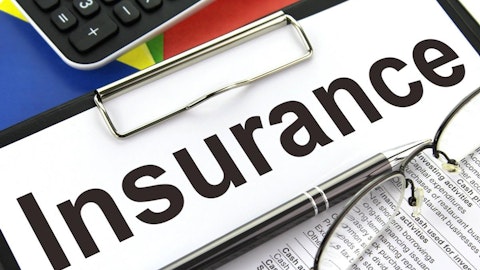However, on the current accident year loss ratio, we’re not where we want to be yet. We still have areas in our business where that current accident year loss ratio is higher than we want it to be. So, as we continue to make improvements and here too we take a very conservative approach where even though we see the improvements being made, they’re coming through in the short term. We are very reluctant to lower accident year loss picks until we have a high degree of confidence that they’ll hold. And so we’ve gone very slowly. Maybe we think I’ll give an example, maybe we think that we’ve improved the loss ratio by 5 points, but our pick maybe we will only pick 1 point Improvement in the PIC, and gradually get to where we think we are. So the point being that we would expect over time the accident year loss ratio to trend lower, but we would also expect going back to where I started that this high level of favorable prior year loss development, it won’t be sustained.
Gregory Peters: That’s helpful. I’m kind of smiling as I hear Chicago’s finest driving back to the station from lunch hour, it seems to be a quarterly tradition with your conference calls.
Craig Smiddy: What would be an Old Republic International conference call without the Chicago Fire Department?
Gregory Peters: That’s returning from lunch. Exactly. Can we pivot, my last question? I’d like to give Carolyn some an opportunity to talk. And I think in your prepared remarks, Carolyn, you talked about technology investments. And with revenue having declined so substantially in title, curious how the technology budget has changed with the lower revenues and how you think about these investments going forward?
Carolyn Monroe: So we’re very mindful of the way the slower revenues, but there’s just some things that when you’re a company that manages for the long run, you have to continue doing. And we are fortunate that we’ve been allowed to continue investing in our technology and a lot of it has to do with being prepared for with the cyber issues, that type of thing, it just isn’t the right time to really cut back. We have put some things that maybe we could say were a lower priority that we’ve set aside, but the things that really help us manage our business that helped make it easier to do business with us, that enabled us to be more efficient. We really didn’t have to cut back doing we’re allowed to continue with those investments.
Gregory Peters: Okay, fair enough. Well, thank you for the answers.
Carolyn Monroe: Thank you.
Craig Smiddy: Thank you, Greg.
Operator: [Operator Instructions]. Our next question comes from Greg Powell from Miller/Howard Investments. Please go ahead. Your line is open.
Greg Powell: Hi. My question is about the Runoff business. I was little surprised that you had a loss on that sale, given that you’ve been dividend and cash out of it. So I have two questions. Could you just explain the loss? And second, is the $25 million the last dividend from that unit?
Craig Smiddy: Sure. I’d be happy to start with the easy part, which is, yes. The $25 million is the last dividend. The other part of the question is there are several factors here. You look at what mortgage insurance companies are valued at right now and they’re valued at approximately book value. And then you compare that to a runoff mortgage company without any new business coming in and the valuation, which we did a very robust market evaluation of with our investment banker and a very robust bidding process, I believe there were about actually 30 different parties that we reached out to. The valuation was actually very good in our opinion and in many other outsider’s opinion as to where we ultimately sold the business. The thing you have to look at is the diminishing level of premium that is occurring in that book of business, as it is run off and the diminishing level of reserves Commensurate with that premium and then ultimately how much going forward we would be able to generate additional revenue that would allow us to produce a profit and release much more capital at some point, things like fixed expenses hit a point where you just can’t cut anymore and premiums are coming down.
So you hit a point where you actually will create an earnings drag and that makes it very difficult to produce revenue and the ability to release capital diminishes over time. So we really hit an inflection point where it made perfect sense to enter into the sales, even though it was at a loss to book value. We think over time, again, we would have seen an earnings drag and not been able to release the levels of capital that we had extracted. We had extracted a large amount of capital, since the business went into runoff and again, we were hitting an inflection point.
Greg Powell: Okay. Can you tell us what’s the book value?
Craig Smiddy: The book value you’re saying that at year end? It’s about $170 million at year end. Okay. So 80% of that component was 80% price for the sale and then we have transaction costs. The net affect loss should be about $30 million.
Greg Powell: Okay. Got you. Thank you. And just on the commercial auto, could you just maybe give us a little more confidence that the 10% price increases are enough?




